This post may contain affiliate links. Please read our disclosure policy.
Baba Ganoush is a smokey, creamy, and flavorful Middle Eastern dip made with oven-roasted eggplant, tahini, garlic, and lemon juice. It’s super easy to make, gluten-free, vegan, low-carb, and a delicious alternative to hummus!
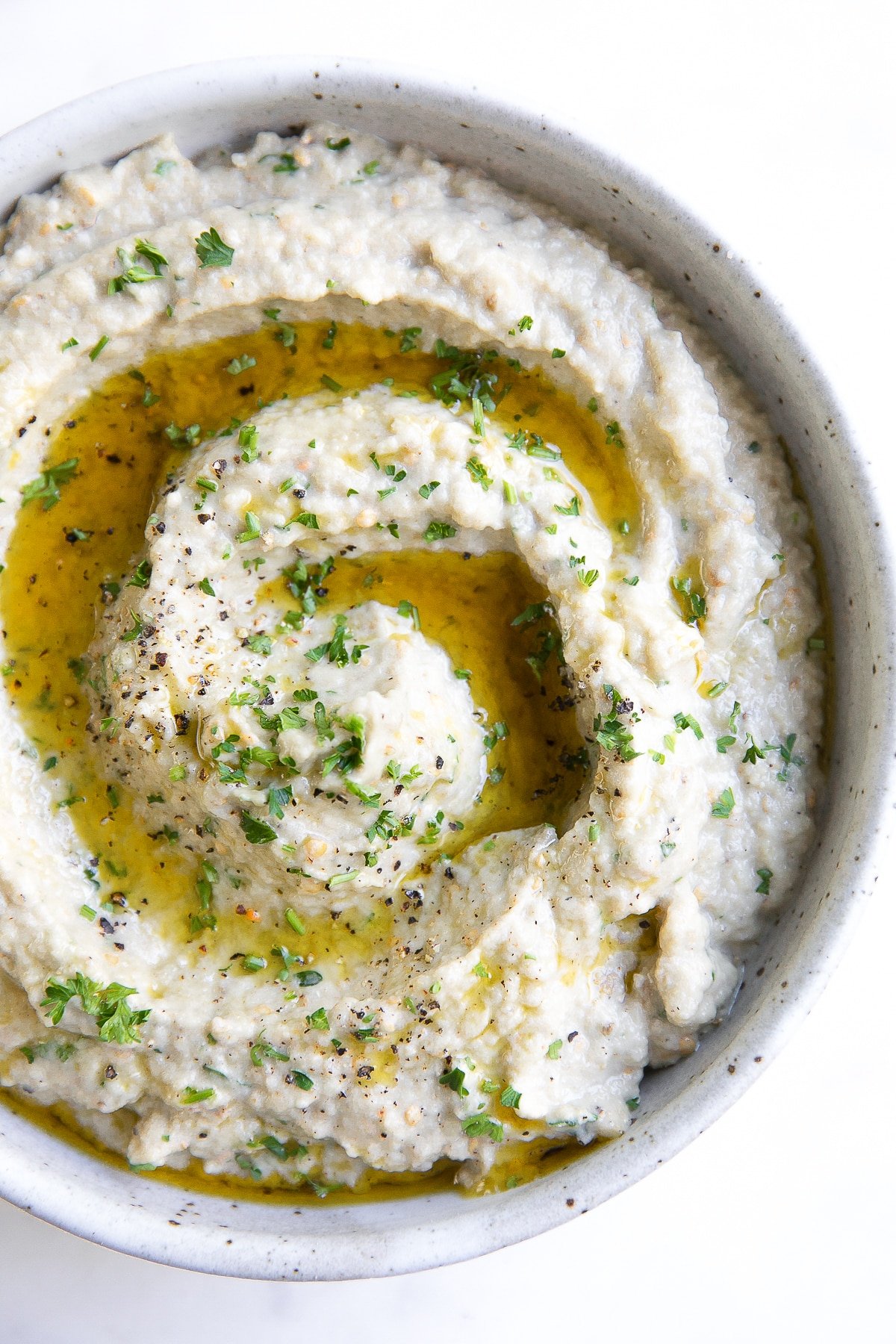
Baba ganoush is my all-time favorite dip – especially when it’s served with soft, warm flatbread.
What is Baba Ganoush?
Baba ganoush is an Eastern Mediterranean appetizer consisting of roasted eggplant blended together with tahini, olive oil, lemon juice, and garlic. Also known as baba ghanoush or baba ghanouj, the eggplant is traditionally roasted over an open flame or in an oven with the skin on. The result is soft and smoky flesh which gives baba ganoush its unique and addictive flavor.

Key Ingredients
Find the printable recipe with measurements in the recipe card below.
- Eggplant—You’ll want 2-3 large globe eggplants. Big and meaty, these are the largest of all the eggplant varieties, which is why they are especially well suited for grilling, roasting, and, yes, dips! Because of their large size, I recommend sprinkling them with salt and allowing them to release some of their water before baking.
- Tahini—Made from toasted, ground, and hulled sesame seeds, tahini is used in recipes such as baba ganoush, hummus, and halva. Due to the growing popularity of hummus in the US over the past decade, it’s easy to find tahini in most of the major supermarkets. You can also make homemade tahini.
- Olive oil—Olive oil coats the eggplant for roasting and is added to the dip.
- Lemon Juice—Start with less and add more as needed. Fresh lemon juice is always recommended.
- Fresh Garlic—It is better to start with less garlic (1-2 cloves) and only add more after tasting. Garlic easily overwhelms the other flavors, so unless you really love a super garlicky baba ganoush, start with less and as much as needed.
- Salt and Black Pepper—You will need some salt and you will need some pepper. How much is entirely up to you.
How to make Baba Ganoush
1. Prepare the Eggplant: Preheat oven to 425 degrees F and set the oven rack to the top third of the oven. Line a large baking sheet with aluminum foil. Slice each eggplant in half from stem to tip. Use a sharp knife to slice long shallow slits in the flesh (not the skin) and generously sprinkle with salt. Allow the eggplant to rest for approximately 10-15 minutes. After that time, use a paper towel to wipe away as much excess liquid and salt as possible. Transfer the eggplant halves to the prepared baking sheet, flesh-side-down. Drizzle with olive oil and sprinkle with salt and pepper.
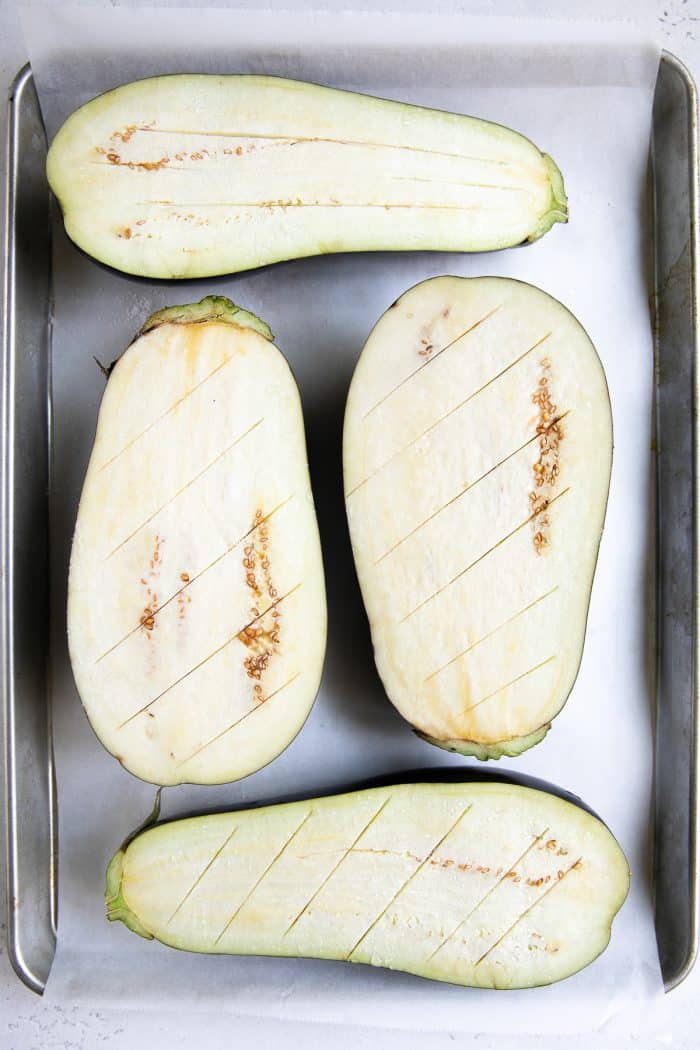

2. Roast the Eggplant: Transfer the baking sheet to the oven and roast for 30-40 minutes or until the eggplant’s skin is shriveled and softened. Remove the baking sheet from the oven and cover with foil to steam the eggplant and continue cooking (this will also make it easier to peel away the skin).
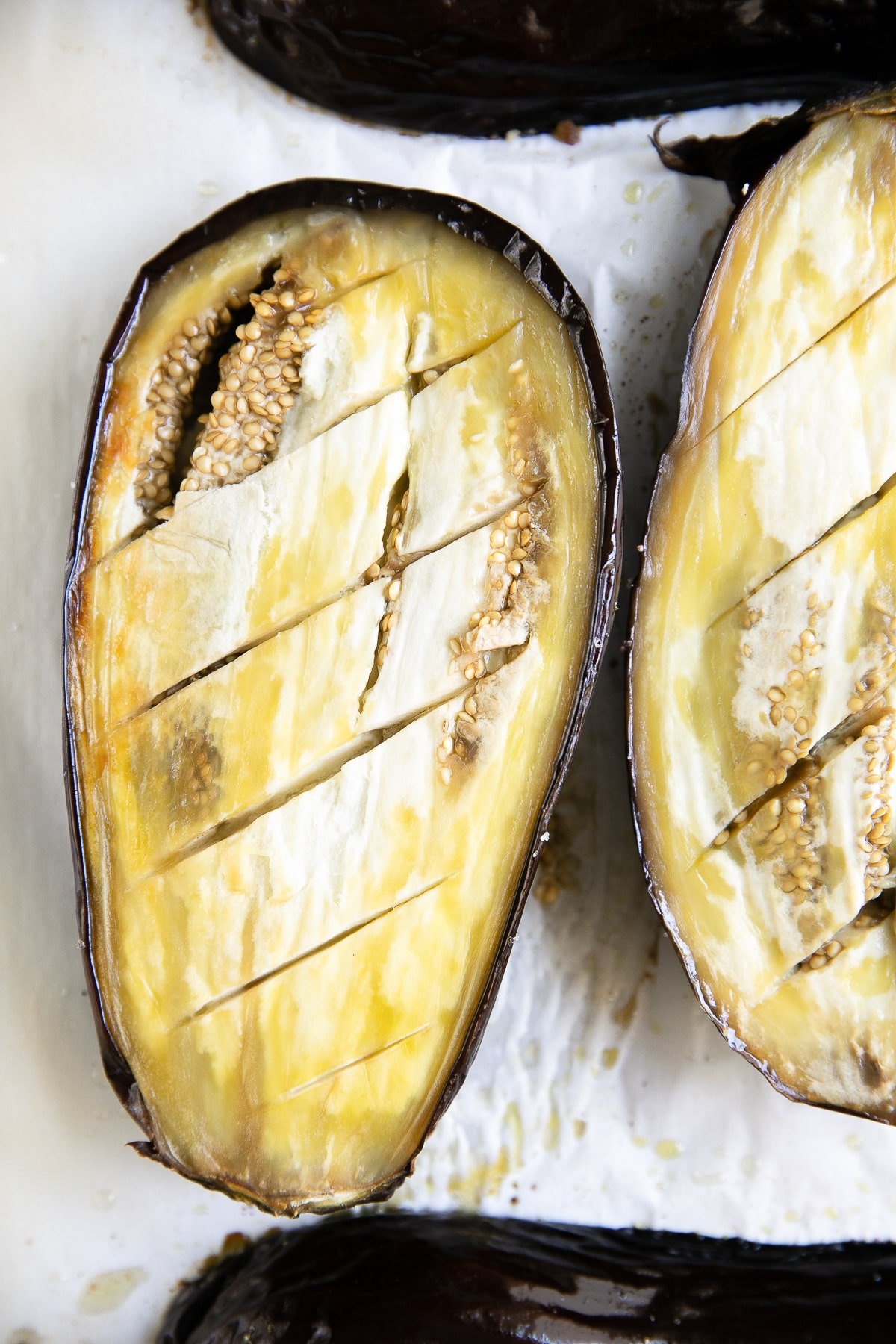
3. Blend and process: After 5-10 minutes, remove the foil from the baking sheet. Carefully peel away the skin from the cooked eggplant flesh (it will be hot so be careful!) and transfer the flesh to the bowl of a large food processor. Add the lemon juice, salt, pepper, olive oil, tahini, and garlic. Process until smooth and creamy. Season with additional salt, pepper, and tahini, to taste.
4. Serve. Serve garnished with freshly chopped parsley, olive oil, and sesame seeds.
If you don’t have a food processor, you may also blend your baba ganoush using a blender or even by hand. Keep in mind that in order to get the creamiest dip possible, you will have the best luck using a food processor or blender (plus, you’ll save loads of time!)
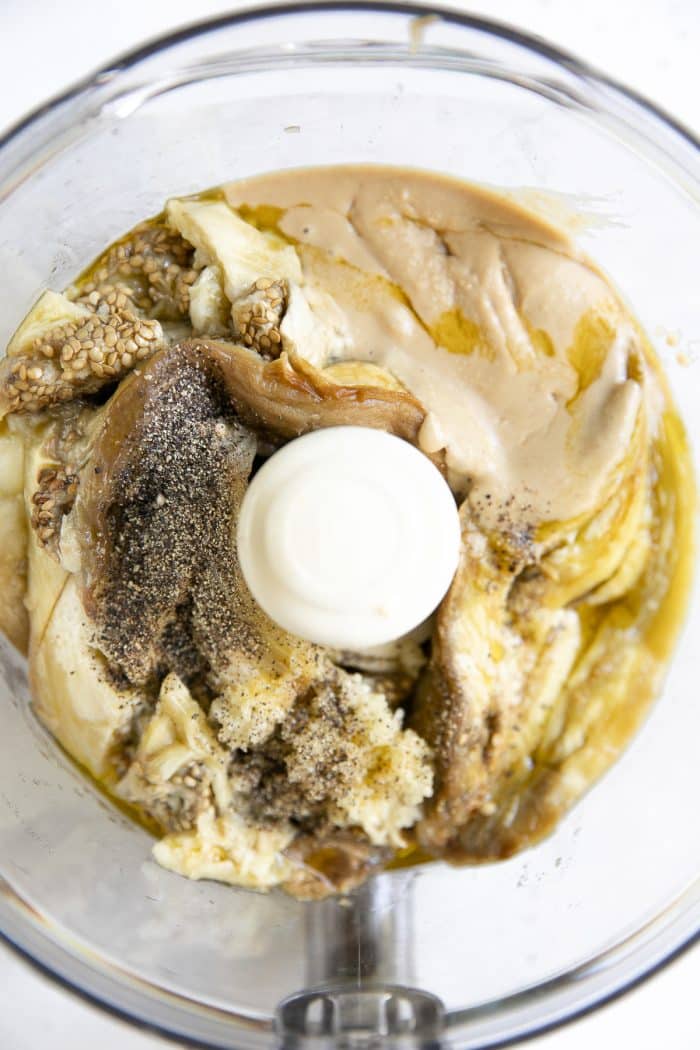
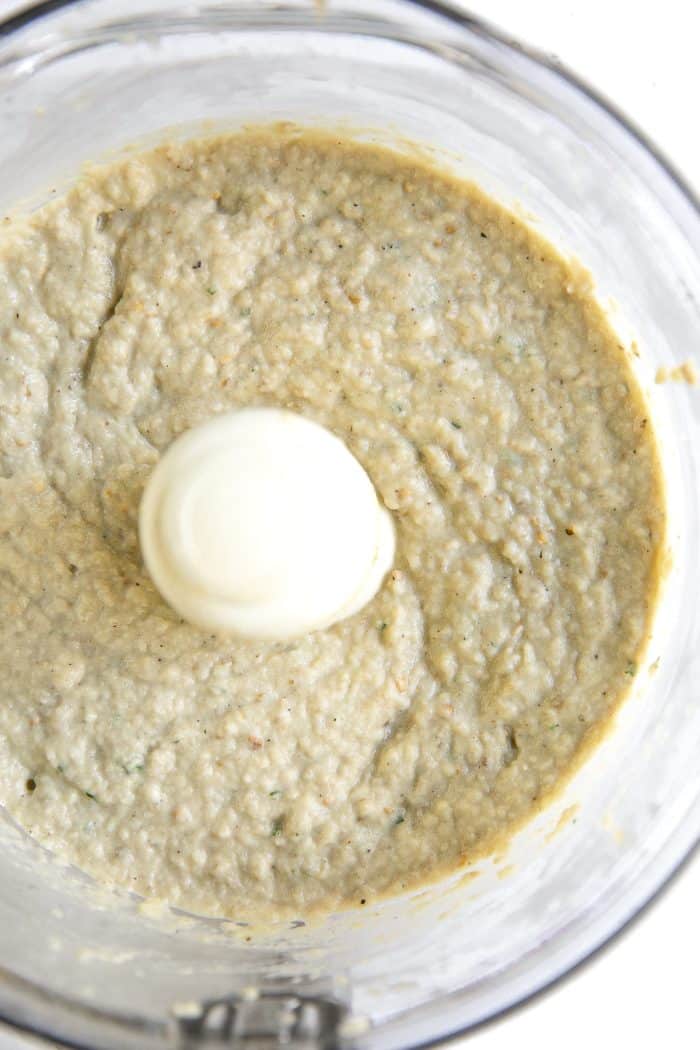
Tips and Tricks
- Prepare your baba ganoush ahead of time. If you’re planning to bring a big bowl to a party, I highly recommend preparing this the day before. Just like many of my favorite soups and stews, baba ganoush actually tastes better the next day once the flavors have had a chance to meld together.
- Add some yogurt to make it extra creamy. If you’re looking for that little bit of extra creaminess, add a couple of tablespoons of plain Greek yogurt.
- Adjust the ingredients to suit your tastes. This is especially apparent with the tahini, salt, and garlic.
- Typically baba ganoush is made without the skin. However, the skin is filled with tons of vitamins and nutrients, so if you’re feeling a little adventurous, leave a little skin on and blend it all together. I double you’ll even notice it’s there.
How to Serve Baba Ganoush
Baba ganoush is commonly served drizzled with olive oil and sprinkled with fresh herbs like parsley. You can also sprinkle it with a little sumac, zaatar, or Aleppo pepper flakes.
It is often served with pita bread or pita chips or as part of a mezze platter, a collection of small dishes that may include tabbouleh, tzatziki, dolma, falafel, hummus, shish taouk, Muhammara, and Israeli salad.
It’s also fantastic wrapped in a large flatbread with grilled chicken, fresh salad, and tomatoes or with a side of warm rice, grilled tomatoes, fresh pita, and a sprinkle of sumac.
Difference Between Baba Ganoush and Hummus
Baba ganoush and hummus may look similar, but they are not the same. Here’s what makes them different:
- The primary ingredient. Hummus is made with a base of chickpeas, while baba ganoush is made with a base of roasted eggplant. Common ingredients shared between the two (typically) include lemon juice, tahini, garlic, and olive oil.
- The taste. Hummus is nuttier, with somewhat bean-like undertones. Baba Ganoush, on the other hand, has a smoky flavor given the method of cooking the eggplant.
- The texture. Hummus is creamier and often thicker. Baba ganoush has a higher volume of water (given the nature of eggplant), so it tends to be slightly chunkier.

How to Store Baba Ganoush
Store leftover baba ganoush in an airtight container in the refrigerator for up to one week.
Can I Freeze Baba Ganoush?
Yes!
- If warm, allow your baba ganoush to cool to room temperature before transferring to a wire mesh strainer lined with two or three layers of cheesecloth. Set the strainer over a large bowl and transfer it to the refrigerator so that it continues to cool as it strains – approximately 1 hour.
- Transfer the baba ganoush to a large ziplock plastic bag, removing as much air as possible. Seal tightly.
- Lay the bag flat on a small baking sheet and transfer it to the freezer. Allow the baba ganoush to freeze completely before removing the baking pan from the freezer.
- Best if used within three months.
To thaw: Remove the baba ganoush from the freezer and allow it to thaw at room temperature for approximately 15-30 minutes or until you are able to start breaking it apart using your hands. Transfer the still semi-frozen baba ganoush to a mesh strainer lined with cheesecloth to drain any extra water resulting from ice crystals formed during freezing. Once thawed, transfer to a bowl and refresh with a squeeze of fresh lemon juice and chopped parsley.
More Dip Recipes,
- BBQ Chicken Dip Recipe
- Hot Crab Artichoke Dip Recipe
- The Best Buffalo Chicken Dip Recipe
- Ricotta and White Bean Dip with Roasted Strawberries
- Beet Hummus
- Easy Black Bean Dip Recipe
If you try making this Baba Ganoush Recipe, please leave me a comment and let me know! I always love to hear your thoughts.
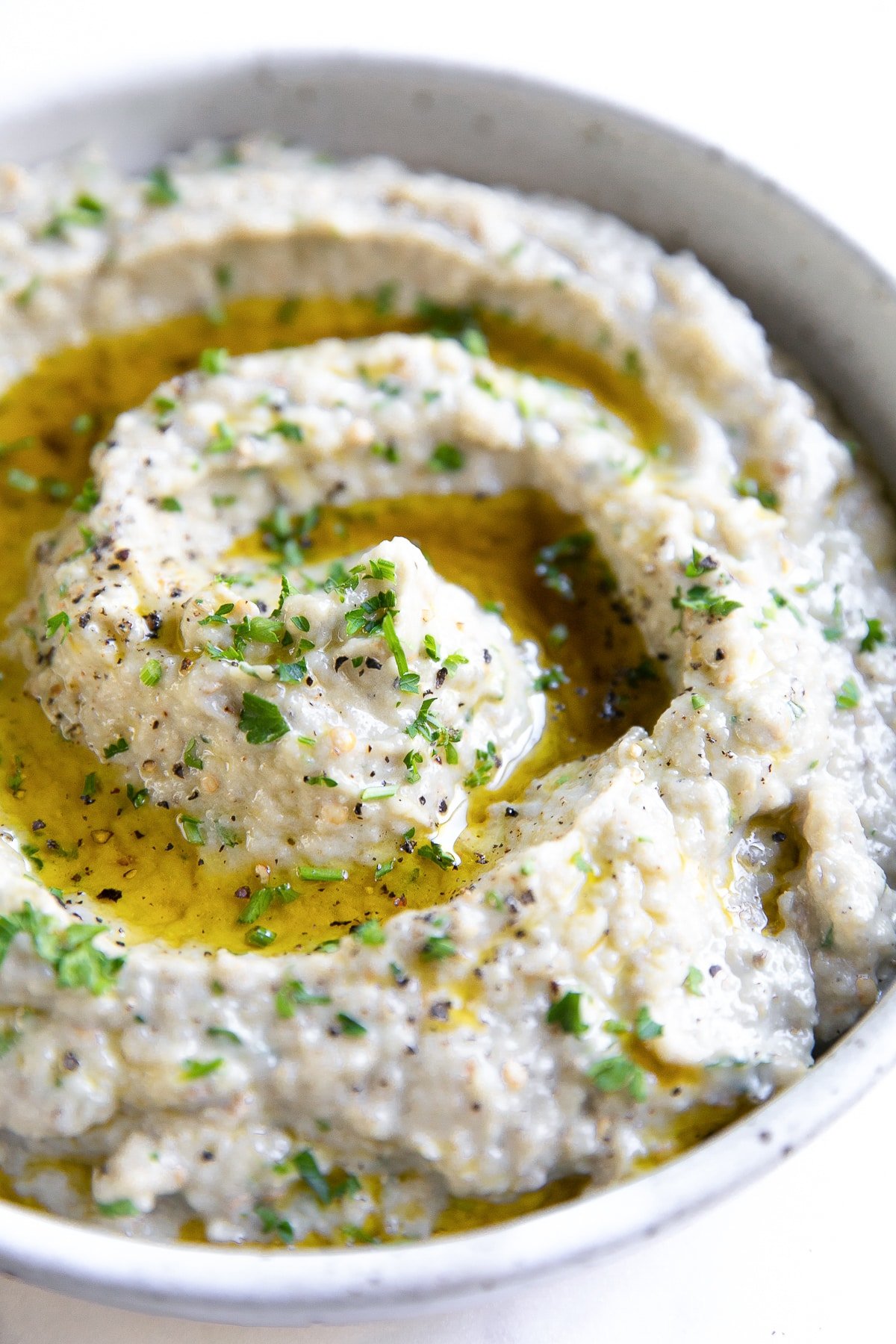
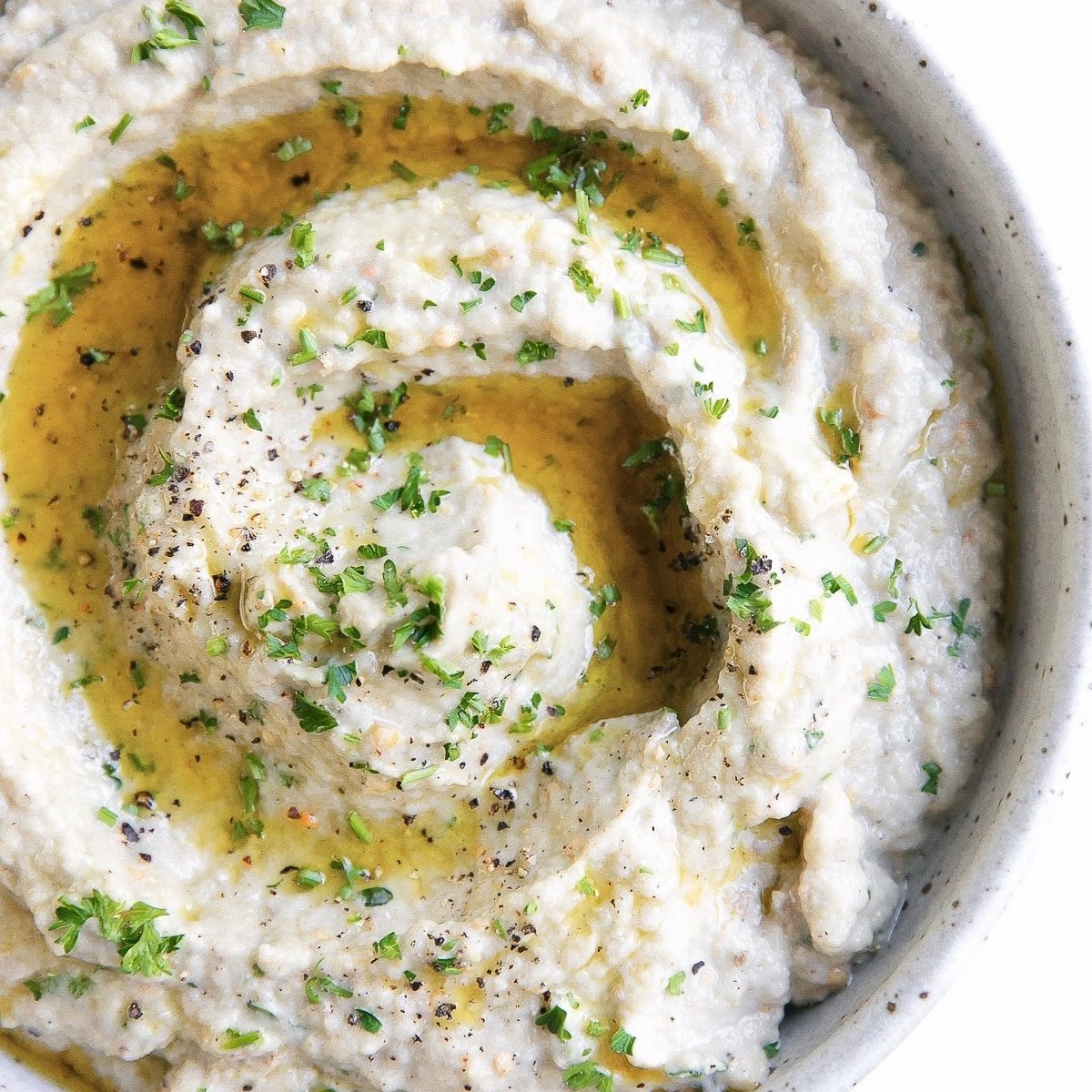
Baba Ganoush Recipe
Equipment
Ingredients
For the Roasted Eggplant
- 2 large globe eggplant
- olive oil, for roasting
- salt + pepper
For the Baba Ganoush
- 2 tablespoon fresh lemon juice
- ½ teaspoon salt
- ½ teaspoon freshly ground black pepper
- 2 tablespoon olive oil
- ⅓ cup tahini
- 2 cloves garlic, minced
- 1 tablespoon fresh parsley, to garnish
Instructions
- Preheat oven. Preheat oven to 425 degrees F and set oven rack to the top third of the oven. Line a large baking sheet with aluminum foil.
- Prepare eggplant. Slice each eggplant in half horizontally along the y-axis. Use a sharp knife to slice shallow slits in the flesh and generously sprinkle with salt. Allow the eggplant to rest for approximately 10-15 minutes. After that time, use a paper towel to wipe away as much moisture and salt as possible. Transfer eggplant halves to the prepared baking sheet, flesh-side-down. Drizzle with olive oil and sprinkle with salt and pepper.
- Bake. Transfer baking sheet to the oven and roast for 30-40 minutes or until softened and the skin of the eggplant is shriveled. Remove baking sheet from the oven and cover with foil to steam the eggplant and further cooking.
- Blend and process. After 5-10 minutes, remove foil from the baking sheet. Carefully peel away the skin from the eggplant flesh (it will be hot!) and transfer the flesh to the bowl of a large food processor. Add the lemon juice, salt, pepper, olive oil, tahini, and garlic. Process until smooth and creamy. Season with additional salt, pepper, and tahini, to taste.
- Serve. Serve garnished with freshly chopped parsley, olive oil, and sesame seeds, if desired. Serve with pita bread, fresh veggies, and crackers. Refrigerate in a sealed container for up to 3 days.
Notes
- Transfer leftovers to an airtight container and place in the refrigerator for up to one week.
- For best results, make this dip at least a few hours or up to one day in advance.
Nutrition
Nutrition information is automatically calculated, so should only be used as an approximation.
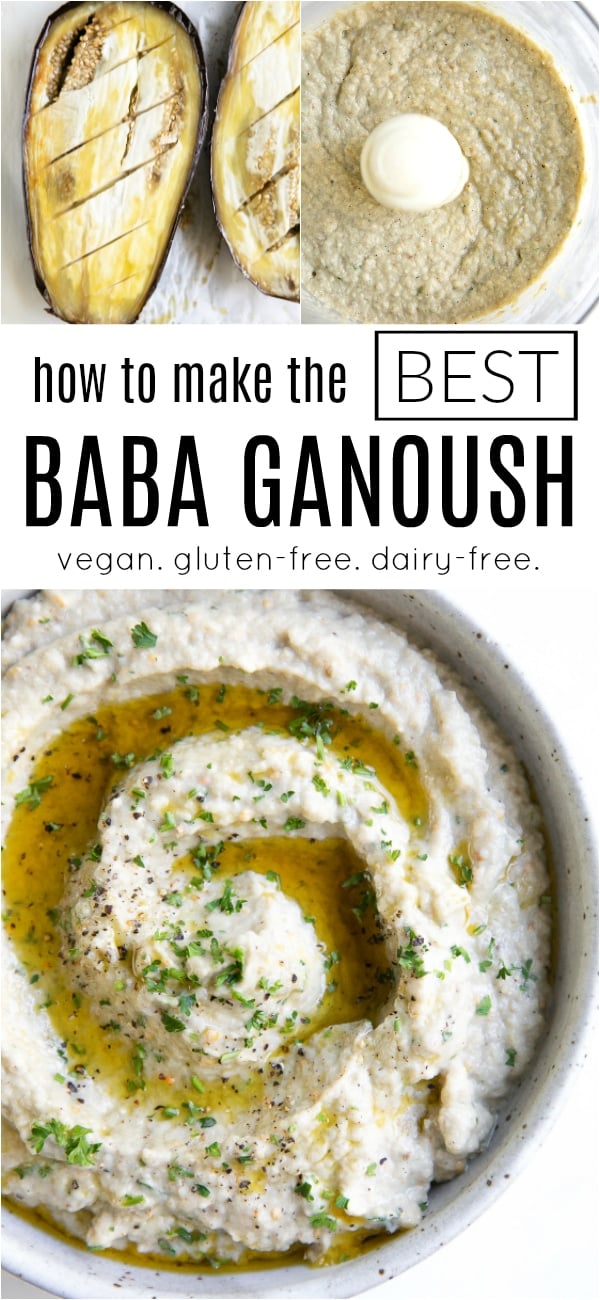













This recipe is ABSOLUTELY FABULOUS!! I make it EVERY time 👌
This had become one of my go-to recipes. It’s delicious with Rosemary-Thyme crackers and fresh veggies. Thank you so much!
Thanks for the kind feedback Kerry, rosemary-thyme crackers sound delightful with it 🙂
Hi Jessica! I am going to try this recipe tonight, but I’m curious as to why you put olive oil, salt and pepper on the skin side of the eggplant if it is going to be discarded after roasting. Did I misunderstand the instructions? Thanks!
It’s part of the roasting process, and part of the olive oil does get through the skin 🙂
This was so easy and delicious! My daughter arrives tomorrow so I made it as a surprise for her. We shared some last month and I was amazed that I liked it. Found your recipe and it’s definitely a keeper. Thanks for sharing.
Easy recipe…and easy to adjust to your taste. Who would have thought eggplant could be so yummy. Thanks for sharing the recipe and insight into eggplant. In the past I haven’t been a fan of eggplant except for scallopini and Indian style. This just opened up a whole new foray into this unusual vegetable!! Delicious!
Thanks Ursula, I am glad you found it delicious 🙂
By far my favourite baba ganoush recipe!
Thanks Tori 🙂
Mine too!!
Can this be made without tahini?